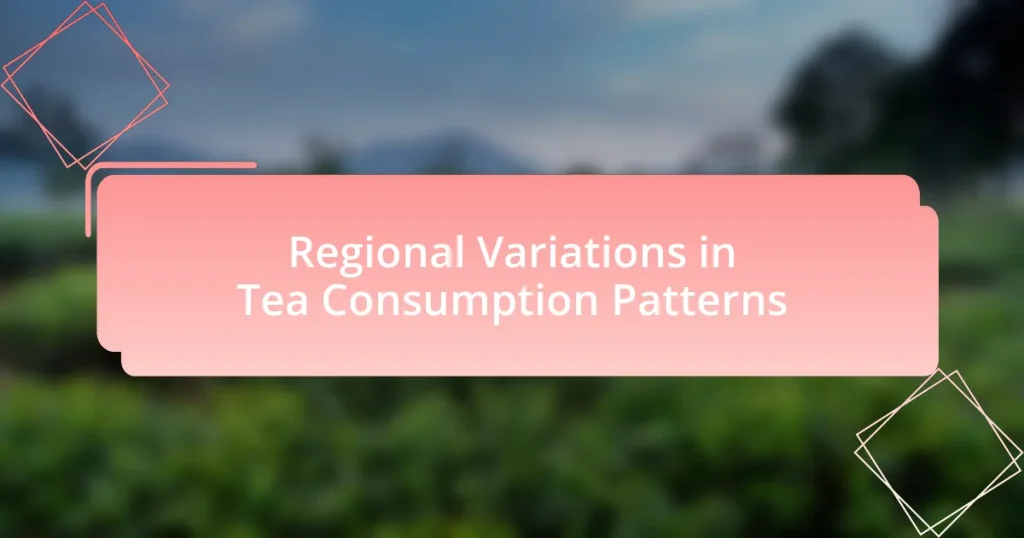The article examines regional variations in tea consumption patterns, highlighting key factors such as cultural preferences, economic conditions, climate, and the availability of tea varieties. It explores how cultural traditions and historical events shape tea drinking habits, with specific examples from countries like China, the UK, and India. Additionally, the article discusses the impact of climate on tea preferences, seasonal variations in consumption, and the influence of economic factors on purchasing behavior. It also addresses emerging trends in global tea consumption, including the rise of health-conscious choices and the effects of globalization and social media on local markets.

What are the key factors influencing regional variations in tea consumption patterns?
Key factors influencing regional variations in tea consumption patterns include cultural preferences, economic conditions, climate, and availability of tea varieties. Cultural preferences dictate the types of tea consumed, as seen in countries like China, where green tea is favored, while in the UK, black tea predominates. Economic conditions affect purchasing power and consumption levels; for instance, higher income levels in developed nations correlate with increased tea consumption. Climate influences the types of tea that can be grown and consumed; regions with cooler climates may prefer hot tea, while warmer areas might favor iced tea. Additionally, the availability of specific tea varieties, shaped by local agriculture and trade, further diversifies consumption patterns across different regions.
How do cultural traditions impact tea consumption in different regions?
Cultural traditions significantly influence tea consumption patterns across different regions. For instance, in China, tea is deeply embedded in social rituals and ceremonies, such as the Gongfu tea ceremony, which emphasizes the art of brewing and serving tea, reflecting the cultural value placed on hospitality and respect. In contrast, British tea culture centers around afternoon tea, a social event that originated in the 19th century, highlighting the importance of leisure and social interaction in British society. Additionally, in Japan, the tea ceremony, or Chanoyu, embodies Zen principles and aesthetics, showcasing the spiritual and meditative aspects of tea drinking. These examples illustrate how cultural practices shape not only the methods of tea preparation and consumption but also the social contexts in which tea is enjoyed, reinforcing the idea that tea is more than just a beverage; it is a cultural symbol that varies widely across different societies.
What specific cultural practices influence tea drinking habits?
Cultural practices significantly influence tea drinking habits through rituals, social customs, and historical traditions. For instance, in China, the Gongfu tea ceremony emphasizes precision and artistry in brewing, reflecting the cultural value placed on harmony and respect for nature. In Japan, the tea ceremony, or Chanoyu, embodies Zen principles and mindfulness, showcasing the importance of aesthetics and tranquility in social interactions. Additionally, in British culture, afternoon tea serves as a social event, highlighting the role of tea in fostering community and hospitality. These practices shape not only how tea is consumed but also the social contexts in which it is enjoyed, reinforcing cultural identity and community bonds.
How do historical events shape tea consumption in various areas?
Historical events significantly influence tea consumption patterns across different regions. For instance, the British colonization of India in the 18th century led to the establishment of tea plantations, which not only increased local consumption but also transformed India into a major exporter of tea. Similarly, the Opium Wars in China during the 19th century disrupted traditional tea trade routes and shifted consumption patterns, as Western demand for tea surged, leading to the establishment of new markets in Europe and America. These historical contexts illustrate how political and economic changes directly affect tea consumption behaviors and preferences in various areas.
What role does climate play in tea consumption patterns?
Climate significantly influences tea consumption patterns by affecting both the production and preference for different types of tea. For instance, warmer climates tend to increase the consumption of iced teas, while cooler climates favor hot tea varieties. Research indicates that regions with high humidity and temperature, such as Southeast Asia, see a higher demand for refreshing iced teas, whereas colder regions, like Northern Europe, exhibit a preference for robust hot teas, particularly during winter months. This correlation between climate and consumption is further supported by market data showing that countries with distinct seasonal variations, such as Japan and China, have developed unique tea cultures that align with their climatic conditions, impacting both the types of tea produced and the consumption habits of their populations.
How does temperature affect the types of tea consumed?
Temperature significantly influences the types of tea consumed, as different temperatures enhance or diminish specific flavors and aromas. For instance, hot temperatures typically favor the consumption of black and herbal teas, which release robust flavors when steeped in boiling water. Conversely, cooler temperatures often lead to a preference for lighter teas, such as green or white teas, which are best enjoyed at lower temperatures to preserve their delicate taste profiles. Research indicates that in warmer climates, iced teas and cold brews are more popular, reflecting a shift in consumption patterns based on ambient temperature. This correlation between temperature and tea choice is evident in various cultures, where seasonal variations dictate the preferred tea types, thus demonstrating the impact of temperature on tea consumption.
What are the seasonal variations in tea consumption across regions?
Tea consumption varies seasonally across regions due to climatic conditions and cultural practices. In colder regions, such as Northern Europe and parts of Asia, tea consumption peaks during winter months as people seek warmth and comfort from hot beverages. Conversely, in tropical regions like Southeast Asia, tea consumption is higher during the cooler months, typically from November to February, as the heat during the summer months leads to a preference for iced tea or lighter beverages.
In countries like China and India, seasonal festivals also influence tea consumption patterns, with increased consumption during specific harvest seasons and festivals. For instance, in China, the spring season sees a surge in the consumption of fresh green teas, while in India, the monsoon season prompts a rise in the popularity of masala chai.
Statistical data from the International Tea Committee indicates that global tea consumption increases by approximately 10% during the winter months in temperate regions, highlighting the significant impact of seasonal variations on tea drinking habits.
How do economic factors influence tea consumption?
Economic factors significantly influence tea consumption by affecting purchasing power, pricing, and consumer preferences. For instance, in countries with higher disposable incomes, such as the United Kingdom, tea consumption tends to be higher due to the ability to afford premium brands and specialty teas. Conversely, in regions with lower economic status, such as parts of Africa, tea consumption may be limited to more affordable options, impacting overall consumption levels. Additionally, fluctuations in tea prices due to economic conditions, such as inflation or changes in supply chains, can directly affect consumer behavior, leading to decreased consumption during times of economic hardship. According to the Food and Agriculture Organization, global tea consumption patterns are closely tied to economic growth rates, indicating that as economies expand, tea consumption typically increases.
What is the relationship between income levels and tea consumption?
Higher income levels generally correlate with increased tea consumption, as wealthier individuals tend to have greater access to a variety of tea products and can afford premium brands. Studies indicate that in regions with higher disposable incomes, such as urban areas in developed countries, tea consumption rises significantly. For instance, a report by the Tea Association of the USA highlights that households with higher income brackets consume more specialty teas, reflecting a trend where tea is viewed as a luxury item. Additionally, research published in the Journal of Consumer Research shows that as income increases, consumers are more likely to explore diverse tea options, leading to higher overall consumption rates.
How do market availability and pricing affect tea choices?
Market availability and pricing significantly influence tea choices by determining the options consumers have and the affordability of those options. When a variety of teas is readily available in a market, consumers are more likely to explore different types, leading to diverse preferences. Conversely, limited availability restricts choices, often resulting in a reliance on a few popular brands or types. Pricing also plays a crucial role; higher prices can deter consumers from purchasing premium teas, while competitive pricing can encourage exploration of various brands and types. For instance, a study by the International Tea Committee indicates that regions with lower tea prices see higher consumption rates, as affordability directly impacts purchasing decisions. Thus, both market availability and pricing shape consumer behavior and preferences in tea consumption.

What are the major regional differences in tea consumption?
Major regional differences in tea consumption include variations in types of tea preferred, preparation methods, and cultural significance. In Asia, particularly in countries like China and Japan, green tea is predominant, often consumed in traditional ceremonies, while in the UK, black tea is favored, typically served with milk and sugar. In India, chai, a spiced tea, is a staple, reflecting local flavors and customs. According to the International Tea Committee, China leads global tea consumption, accounting for approximately 40% of the total, followed by India and Turkey. These differences highlight how cultural practices and local preferences shape tea consumption patterns across regions.
How does tea consumption differ between Asia and Europe?
Tea consumption significantly differs between Asia and Europe, primarily in terms of types, preparation methods, and cultural significance. In Asia, particularly in countries like China and Japan, tea is often consumed as a traditional beverage with a focus on green and oolong varieties, and it is integral to cultural rituals such as the Japanese tea ceremony. In contrast, Europe predominantly favors black tea, often consumed with milk or sugar, and is associated with social practices like afternoon tea in the UK. According to the International Tea Committee, Asia accounts for over 70% of global tea consumption, highlighting its central role in daily life and cultural practices, while Europe represents a smaller but significant market, emphasizing different consumption styles and preferences.
What types of tea are most popular in Asian countries?
The most popular types of tea in Asian countries include green tea, black tea, oolong tea, and herbal tea. Green tea is especially favored in countries like China and Japan, where it is often consumed daily and is integral to cultural practices. Black tea, particularly in the form of Assam and Darjeeling, is predominant in India and Sri Lanka, where it is a major export product. Oolong tea, known for its unique flavor profile, is highly regarded in Taiwan and parts of China. Herbal teas, such as jasmine and chrysanthemum, are also widely consumed across various Asian cultures for their health benefits and aromatic qualities. These preferences reflect both historical significance and regional agricultural practices, contributing to the diverse tea culture in Asia.
How do European tea preferences vary by country?
European tea preferences vary significantly by country, reflecting cultural traditions and historical influences. For instance, in the United Kingdom, black tea is predominant, often consumed with milk, while in Russia, strong black tea is typically served with lemon or jam. In contrast, countries like Turkey favor a strong, unadulterated black tea, often brewed in a double teapot known as a çaydanlık. In the Nordic countries, herbal and fruit teas are popular, with Finland having one of the highest per capita tea consumption rates in Europe, favoring fruit and herbal blends. These variations are supported by market research indicating that cultural practices and local tastes heavily influence tea consumption patterns across Europe.
What are the unique tea consumption patterns in Africa?
Tea consumption patterns in Africa are characterized by a strong cultural significance and regional diversity. In countries like Ethiopia and Kenya, tea is often consumed with milk and sugar, reflecting local preferences for sweetness and creaminess. In contrast, North African nations such as Morocco emphasize mint tea, which is a symbol of hospitality and social gatherings. Additionally, the rise of tea consumption in urban areas is notable, with a growing trend towards specialty teas and health-conscious choices. According to the International Tea Committee, Africa’s tea production has increased significantly, with Kenya being one of the largest producers globally, indicating a robust market and evolving consumption habits.
How does local agriculture influence tea drinking in African nations?
Local agriculture significantly influences tea drinking in African nations by determining the availability and variety of tea produced. Countries like Kenya and Malawi, which have favorable climates for tea cultivation, contribute to a robust local tea industry, making tea more accessible and culturally integrated into daily life. For instance, Kenya is one of the largest tea producers globally, with over 500,000 smallholder farmers involved in tea cultivation, which not only supports local economies but also promotes tea consumption among communities. The presence of local tea varieties and the promotion of tea as a staple beverage further enhance its popularity, leading to unique regional consumption patterns that reflect agricultural practices and local preferences.
What traditional ceremonies involve tea in African cultures?
Traditional ceremonies that involve tea in African cultures include the Ethiopian coffee ceremony, which often incorporates tea as part of the hospitality ritual, and the Mauritian tea ceremony, where tea is served during family gatherings and celebrations. In Ethiopia, the coffee ceremony is a significant social event that may feature tea alongside coffee, highlighting the importance of beverage sharing in community bonding. In Mauritius, tea is an integral part of cultural celebrations, reflecting the island’s diverse heritage and the role of tea in social interactions. These ceremonies underscore the cultural significance of tea in fostering relationships and community ties across various African cultures.
How do North American tea consumption patterns compare to other regions?
North American tea consumption patterns are significantly lower than those in regions like Asia and Europe. In North America, tea consumption averages about 0.5 kg per person annually, whereas in countries such as China and India, the figures exceed 1 kg per person, with China reaching approximately 2.5 kg per person. This disparity is attributed to cultural preferences, with North Americans favoring coffee over tea, while tea is deeply integrated into daily life in many Asian cultures. Additionally, the types of tea consumed differ; North Americans predominantly drink black tea and herbal infusions, while Asian countries have a diverse range of green, oolong, and specialty teas.
What trends are emerging in tea consumption in the United States and Canada?
Emerging trends in tea consumption in the United States and Canada include a significant increase in the popularity of specialty teas, particularly herbal and wellness-focused varieties. According to the Tea Association of the USA, the overall tea market has grown, with herbal tea sales rising by 20% from 2019 to 2021, reflecting a shift towards health-conscious choices among consumers. Additionally, there is a growing interest in sustainable and ethically sourced teas, driven by consumer awareness of environmental issues. This trend is supported by a report from the Canadian Tea Association, which indicates that 60% of Canadian tea drinkers prefer brands that prioritize sustainability.
How do health trends influence tea choices in North America?
Health trends significantly influence tea choices in North America by driving consumer preferences towards healthier options. For instance, the increasing awareness of health benefits associated with tea, such as antioxidants in green tea and the calming effects of herbal teas, has led to a surge in their popularity. According to a 2021 report by the Tea Association of the USA, green tea consumption rose by 30% over the past five years, reflecting a shift towards beverages perceived as healthier. Additionally, trends like organic and functional teas, which claim added health benefits, have gained traction, with sales of organic tea increasing by 20% annually. This shift illustrates how health consciousness shapes the tea market in North America, leading consumers to prioritize options that align with their wellness goals.

What are the emerging trends in global tea consumption?
Emerging trends in global tea consumption include a significant increase in demand for specialty teas, health-focused blends, and sustainable sourcing practices. The rise of specialty teas, such as matcha and herbal infusions, reflects consumers’ growing interest in unique flavors and health benefits. According to a report by Grand View Research, the global specialty tea market is projected to reach $20.3 billion by 2025, indicating a robust growth trajectory. Additionally, health-conscious consumers are increasingly opting for teas with functional ingredients, such as adaptogens and antioxidants, which cater to wellness trends. Furthermore, sustainability has become a priority, with brands focusing on organic farming and eco-friendly packaging, as evidenced by the 2021 Tea Sustainability Index, which highlights a shift towards environmentally responsible practices in tea production.
How is the rise of health consciousness affecting tea consumption patterns?
The rise of health consciousness is significantly increasing tea consumption patterns, as consumers increasingly seek beverages that offer health benefits. This trend is evidenced by a growing preference for green tea, herbal teas, and specialty blends that are marketed for their antioxidant properties, weight management benefits, and overall wellness support. According to a report by Grand View Research, the global green tea market is expected to reach $33.76 billion by 2025, driven by the health-conscious demographic prioritizing natural and functional beverages.
What health benefits are associated with different types of tea?
Different types of tea offer various health benefits. Green tea is known for its high antioxidant content, particularly catechins, which can enhance metabolism and support weight loss. Black tea contains flavonoids that may improve heart health by reducing cholesterol levels and improving blood vessel function. Herbal teas, such as chamomile, can promote relaxation and improve sleep quality, while peppermint tea may aid digestion and relieve headaches. Oolong tea has been linked to improved mental alertness and may assist in weight management. These benefits are supported by studies, such as those published in the Journal of Nutrition, which highlight the positive effects of tea consumption on overall health.
How are herbal teas gaining popularity in various regions?
Herbal teas are gaining popularity in various regions due to increasing health consciousness among consumers. This trend is supported by a growing body of research indicating that herbal teas offer numerous health benefits, such as improved digestion, enhanced immunity, and stress relief. For instance, a study published in the Journal of Medicinal Food highlights the antioxidant properties of herbal teas, which contribute to their appeal as a healthier beverage choice. Additionally, the rise of wellness culture and the influence of social media have further propelled the interest in herbal teas, as consumers seek natural alternatives to traditional caffeinated beverages.
What impact does globalization have on local tea consumption habits?
Globalization significantly alters local tea consumption habits by introducing diverse tea varieties and influencing consumer preferences. As global trade expands, local markets gain access to international brands and specialty teas, which can shift traditional consumption patterns. For instance, in countries like India and China, the influx of Western tea culture has led to increased popularity of specialty teas such as green and herbal teas, alongside traditional black tea. This shift is evidenced by a report from the International Tea Committee, which noted a rise in specialty tea sales in these regions, reflecting changing consumer tastes driven by globalization.
How are international brands influencing regional tea markets?
International brands are significantly influencing regional tea markets by introducing diverse product offerings and marketing strategies that cater to local tastes. These brands often leverage their global presence to create premium products, which can shift consumer preferences towards higher-quality teas. For instance, brands like Lipton and Twinings have successfully penetrated various markets by adapting their flavors and packaging to align with regional preferences, thereby increasing their market share. According to a report by Research and Markets, the global tea market is projected to grow at a CAGR of 5.5% from 2021 to 2026, driven in part by the expansion of international brands into emerging markets. This trend illustrates how international brands not only enhance competition but also elevate consumer expectations regarding quality and variety in regional tea markets.
What role do social media and marketing play in shaping tea trends?
Social media and marketing significantly influence tea trends by facilitating the rapid dissemination of information and creating consumer engagement. Platforms like Instagram and TikTok allow brands to showcase innovative tea products and brewing methods, which can quickly gain popularity through visual appeal and influencer endorsements. For instance, the rise of bubble tea in Western markets can be attributed to viral social media posts that highlighted its unique texture and flavors, leading to increased demand. Additionally, targeted marketing campaigns leverage data analytics to identify consumer preferences, enabling brands to tailor their offerings and promotions effectively. This combination of social media visibility and strategic marketing drives the evolution of tea consumption patterns across different regions.
What practical tips can consumers follow to explore regional tea varieties?
Consumers can explore regional tea varieties by visiting local tea shops and markets that specialize in regional products. Engaging with knowledgeable staff can provide insights into the unique characteristics and origins of different teas. Additionally, participating in tea tastings or workshops allows consumers to experience a variety of flavors and brewing techniques specific to each region. Researching online resources, such as tea blogs and forums, can also help consumers discover lesser-known regional teas and their cultural significance. Furthermore, joining tea clubs or communities can facilitate sharing experiences and recommendations with fellow tea enthusiasts, enhancing the exploration process.


